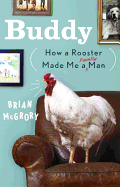
| Publisher: | Crown | |
| Genre: | Love & Romance, Pets, Biography & Autobiography, Family & Relationships, Birds, Personal Memoirs | |
| ISBN: | 9780307953063 | |
| Pub Date: | November 2012 | |
| Price: | $24 |
| Starred | Biography & Memoir |
by Brian McGrory
Brian McGrory, Boston Globe columnist and author of several political thrillers set in Boston, here offers a memoir, Buddy, the tale of (among other things) an unlikely alliance between man and bird. Shifting back and forth in time with several shorter vignettes tying into the larger story of how McGrory met his fiancée, Pam, and her two girls, the book opens on the newly formed family's first morning in their new house in suburban Massachusetts. The day begins with the screeching of a rooster named Buddy. It is immediately clear that McGrory and the rooster have an antagonistic relationship--one that makes the human feel like an outsider in his own home and within his new family. There follows a how-did-I-get-here? moment that anyone can relate to. In his case, McGrory tells us, it began with a dog.
From the moment McGrory lays eyes on Harry, a golden retriever pup shivering in his crate at Logan Airport to a decade later when he begins a relationship with Harry's vet, Pam, to meeting Buddy, McGrory engages the reader. The females, who dote upon Buddy, are his flock, and Buddy soon becomes the metaphor for everything Brian finds uncomfortable and alien about his new life. But relationships bring compromise, and despite his dismay at discovering that chickens can live up to 15 years, he even comes to an understanding approaching empathy for Buddy, who is also often out of his element. Ultimately, McGrory realizes that both he and Buddy are home and that all is right with the world. For now. --Debra Ginsberg, author

| Publisher: | Sourcebooks | |
| Genre: | Biography & Autobiography, Social Science, Women, Penology, Personal Memoirs | |
| ISBN: | 9781402270765 | |
| Pub Date: | November 2012 | |
| Price: | $14.99 |
| Biography & Memoir |
by Sara Lunsford
More than two million people in the United States are locked up under the direct supervision of guards who by proxy represent society. Sweet Hell on Fire, a raw, unfiltered memoir by former correction officer Sara Lunsford, strongly suggests our penal avatars are not preparing convicts for their eventual release well. Ostensibly a purge of her troubled personal life while employed at a prison, Lunsford's chillingly self-assured recounting is actually a fascinating, frightening lens into a simmering underworld most of us would rather not think about.
Unlike Ted Conover's New Jack, Lunsford's work as a CO didn't lead her to conclude that the prison system dehumanizes imprisoner and imprisoned alike. Instead, she prides herself on a "gotta keep 'em down" philosophy even dog trainers have rejected. Lunsford can be oblivious to the impression her indignation-filled memories of sexually mocking and physically intimidating inmates might convey, and to the obvious connections between the casual brutality of her job and the drunkenness and violence in her personal life before she straightened up.
In one of those strange instances where a book succeeds in a completely different way than the author intended, Sweet Hell on Fire is a riveting look inside the mind of a real prison guard--so much different than Conover's role as undercover journalist--and an inadvertent lament for the bilateral sadism between inmates and those who supposedly represent civilized society. As such, Lunsford's account clearly calls into question who in corrections, if anyone, corrects the guards. --Cherie Ann Parker, freelance journalist and book critic
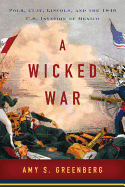
| Publisher: | Knopf | |
| Genre: | United States, State & Local - West, 19th Century, History, Military | |
| ISBN: | 9780307592699 | |
| Pub Date: | November 2012 | |
| Price: | $30 |
| History |
by Amy S. Greenberg
Amy S. Greenberg's A Wicked War offers a fascinating glimpse into the history of the United States' invasion of Mexico, revealing the conflict between James K. Polk's expansionist doctrine of "Manifest Destiny" and the more domestic focus of Henry Clay, Abraham Lincoln and the Whigs. Bubbling beneath the politics of the Mexican War, the U.S. was strongly divided on the question of slavery--and, for that matter, the attitude of many citizens toward anyone with darker skin: Amerindian, mixed-race mestizo or black slave alike. As president, Polk was hardly circumspect about his intentions: "It was God's will," Greenberg quotes, "that Mexico's richest lands, especially the fertile stretch by the Pacific, pass from its current shiftless residents to hardworking white people better able to husband their resources."
From the end of its own war of independence in 1821 until 1845, Mexico installed and overthrew almost 50 presidents. By 1846, it was a vulnerable collection of fragmented states and territories. With substantial popular support, Polk's war brought a weakened Mexico to its knees, swiftly creating a transcontinental American super-power.
Greenberg's smooth narration is filled with original observations and sources that dig into the personalities and politics behind the events. Although successful, Polk's war became a political albatross. It had the highest desertion rate and casualty rate of any American war and spawned the country's first antiwar movement. Ultimately, it forced the country to resolve its deep division over slavery, bringing Lincoln to the White House and sparking the much more devastating Civil War. --Bruce Jacobs, founding partner, Watermark Books & Cafe, Wichita, Kan.
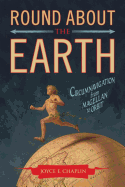
| Publisher: | Simon & Schuster | |
| Genre: | Travel, Expeditions & Discoveries, Essays & Travelogues, Earth Sciences, History, Geography, Science | |
| ISBN: | 9781416596196 | |
| Pub Date: | October 2012 | |
| Price: | $35 |
| History |
by Joyce E. Chaplin
In Round About the Earth, Joyce E. Chaplin (The First Scientific American) describes around-the-world voyages as "geodramas," in which travelers present themselves as actors on a global stage--a metaphor that she extends by dividing her history of circumnavigation into three "acts."
Chaplin begins with the fearful sea voyages of early modern man, when mariners who attempted to sail around the world were as likely to die as not. She moves on to the confident years of the imperial age, when circumnavigation became both a tool and a beneficiary of Western domination. She ends with the renewed fears and challenges of circling the globe that arose first with aviation and then with space travel. The dangers of orbiting the earth in a space ship, she finds, are surprisingly similar to those of circumnavigating the globe in a 15th-century caravel.
Round About the Earth is more than a series of adventures, though Chaplin tells plenty of stories about major and minor figures both: there's Magellan, who didn't actually make it around the globe; Darwin, who never conquered seasickness; and Laika, the first animal in space--whose terror, pain and death were broadcast via radio and television signals. Chaplin intertwines her travelers' accounts with discussions of the political contexts that defined them, the technological innovations that made them easier and, perhaps most interesting of all, the way they were reported. From bestselling 15th-century travelers' accounts to NASA's TV broadcasts, circumnavigation has been about the story as much as about the adventure. --Pamela Toler, blogging at History in the Margins
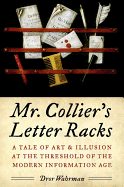
| Publisher: | Oxford University Press | |
| Genre: | Art, Great Britain - General, History, Baroque & Rococo, Europe | |
| ISBN: | 9780199738861 | |
| Pub Date: | September 2012 | |
| Price: | $34.95 |
| History |
by Dror Wahrman
The first question one might ask about Dror Wahrman's Mr. Collier's Letter Racks is: "What's a letter rack?" Popular in the 18th century, letter racks were wooden boards with leather straps attached to hold letters, pamphlets, even a comb or scissors--much like we use magnets on refrigerator doors today. The second question would be: "Who's Mr. Collier?" Edward Collier was an obscure, late 17th-century Dutch/British artist who was a master at painting letter racks with such realistic trompe l'oeil detail they looked like the real thing.
When Dror Wahrman, a history professor at Indiana University, placed some of Collier's paintings side by side, he discovered that the paintings were "intricate puzzles" containing many subtle hidden messages and visual jokes. This "consummate artistic magician" was exploring issues that were just arising thanks to the proliferation of printed matter, newspapers, brochures, pamphlets--all of which he included in his painted letter racks. Collier was worried that so much stuff, so much useless ephemera, could contain untrustworthy information, lies, propaganda and hate-mongering. Collier's messages, his medium, were clear to those who could read them: beware, what you see is what you get--or is it?
Wahrman's deft and revelatory examination of Collier's elaborate visual game offers a timely critique of our information age and the rampant proliferation of vile lies, hatred and purposeful misinformation: what you read and see may be a lie itself. --Tom Lavoie, former publisher
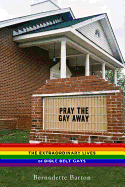
| Publisher: | New York University Press | |
| Genre: | Sociology of Religion, Gay Studies, Social Science, Regional Studies, Discrimination & Racism, Lesbian Studies | |
| ISBN: | 9780814786376 | |
| Pub Date: | October 2012 | |
| Price: | $27.95 |
| Current Events & Issues |
by Bernadette Barton
When sexual orientation is politicized, merely being gay becomes a political act. This is strikingly apparent in America's "Bible Belt," where the overwhelming presence of fundamentalist, evangelical Christians--most of whom oppose homosexuality--affects LGBT people in profound ways at work, at home and in their social lives. In Pray the Gay Away, sociology and women's studies professor Bernadette Barton explores the complex and interlocking conflicts that ensue when one tries to live in or out of the closet in a Bible Belt community.
Pray the Gay Away presents a compassionate, clear-headed exploration of life for gay individuals in the Bible Belt that is instantly refreshing, given the politicized and often polarizing nature of the topic. Barton neither writes off LGBT individuals as sinful nor conservative Christians as bigots. Rather, she humanizes both, presenting personal accounts from gay Bible Belt residents who were disowned, shunned and even attacked by family and friends for their orientation and statements from those for whom church and community are one unit ruled by God's inerrant word as revealed in the Bible--then unifies both groups, pointing out the considerable overlap between them. (Indeed, that overlap is frequently the very source of the inter- and intrapersonal conflict.)
With honest accounts and a frank and open tone, Pray the Gay Away injects some much-needed humanity into the conversation about gay rights and religious freedom. It is a must-read for all points of the political and religious spectrum. --Dani Alexis Ryskamp, blogger at The Book Cricket
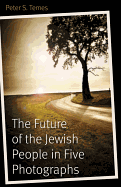
| Publisher: | University of Nebraska Press | |
| Genre: | Anthropology, Social Science, Cultural, Jewish Studies | |
| ISBN: | 9780803239791 | |
| Pub Date: | November 2012 | |
| Price: | $26.95 |
| Current Events & Issues |
by Peter Temes
In the provocative The Future of the Jewish People in Five Photographs, Peter Temes uses a set of images, both iconic and obscure, as touchstones to explore a Jewish future that contains "possibilities hopeful and inspiring but also challenging and troubling."
Temes wonders whether Jews, who today account for only .2% of the world's population, will eventually lose their distinct identity. The first two photographs spotlight the Zoroastrians, whose population, once as high as three million, has shrunk to 200,000, and the Jews of Kaifeng, China, who gradually assimilated into the surrounding population. In the process, Temes notes, these peoples did not become extinct, but instead merely made a "change from one set of ideas to another."
His third photograph, of Reverend Martin Luther King, Jr. and Rabbi Abraham Joshua Heschel marching from Selma to Montgomery in 1965, highlights the tension between Jewish tradition's demand to embrace the cause of social justice and the imperative of self-preservation. A photograph of Adolph Eichmann, on trial for war crimes in Jerusalem in 1961, anchors reflections on the role of Israel in defining the future of the Jewish people.
The final photograph depicts a female rabbi performing the exacting task of repairing a Torah scroll, spurring Temes to consider the importance of traditional Jewish texts and the ongoing conversation in which Jews engage those texts.
In this concise, passionately argued book, Temes provides valuable fodder for many searching conversations about what it will take to carry the Jewish saga into the new millennium. --Harvey Freedenberg, attorney and freelance reviewer
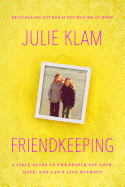
| Publisher: | Riverhead | |
| Genre: | Biography & Autobiography, Women, Personal Memoirs | |
| ISBN: | 9781594488061 | |
| Pub Date: | October 2012 | |
| Price: | $25.95 |
| Psychology & Self-Help |
by Julie Klam
At first glance, Julie Klam, a self-described neurotic New Yorker whose interests include going to bed early, might not seem an obvious choice for a BFF. After reading Friendkeeping, though, you'll want to friend her, on Facebook and IRL.
With so many how-to books on everything from marriage to motherhood, it's pretty awesome that Klam is putting the same amount of effort toward an ode to friendship. Friendships are something people seem to take for granted as we focus on our careers and families--not so with Klam. Even as a child--her family's only daughter, poor thing--she was gaga about her pals. Today, she values her adult friendships just as much.
Klam is nothing if not a loving and loyal friend. The energy she puts into friendship probably explains why she is blessed with a cherished coven of close compadres. She explains how these relationships formed and how she keeps them vibrant, recounting obstacles she overcame along the way.
As she describes the many pitfalls of friendship and how to leap over them, Klam provides advice on what to do if you can't stand a friend's spouse or how to finesse the situation when you get pregnant before a bosom pal who's been trying to conceive for years. She speaks from personal experience and she doesn't care if she looks bad sometimes--traits that instantly make Friendkeeping more authentic and Julie Klam even more endearing. --Natalie Papailiou, author of blog MILF: Mother I'd Like to Friend

| Publisher: | No Starch Press | |
| Genre: | Chemistry, Physical & Theoretical, Inorganic, Science, Comics & Graphic Novels, Nonfiction | |
| ISBN: | 9781593274238 | |
| Pub Date: | September 2012 | |
| Price: | $17.95 |
| Starred | Science |
by Bunpei Yorifuji
Chemistry teachers the world over face a constant battle to open the eyes of students to the joys of the science. They may have the advantage of flames and explosions to capture their classes' imaginations, but the deluge of concepts, terminology and arcane facts can be so abstract as to frighten young pre-frontal cortexes.
In Wonderful Life with the Elements, Japanese artist Bunpei Yorifuji has done all chemistry lovers an enormous service: he has taken the abstract, elemental world and given it a face. Even more: he has given each element its own face, body type, outfit, hairstyle and personality. (Keep in mind, there are currently 118 elements on the periodic table.) In addition, Wonderful Life is littered with little anecdotes and further illustrations that open a window onto Yorifuji's own personality. Take, for instance, the opening story of how a younger, over-eager Yorifuji inhaled a great deal of helium in an effort to "make some really funky noises" and instead discovered that in large quantities helium can cause suffocation. "Helium is dangerous in more than one way," he reflects. "The first is that it suffocates you, and the second is that even if you call for help, your cries will probably be dismissed as a bad practical joke."
The astonishing attention to scientific details demonstrate a sophisticated grasp of the concepts and some serious artistic chops, but the real joy lies in Yorifuji's infectious, playful enthusiasm--bound to draw in even the most entrenched science-phobes. --Katherine Montgomery, book nerd and high school chemistry teacher
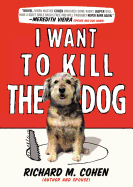
| Publisher: | Blue Rider | |
| Genre: | Pets, General, Humor, Biography & Autobiography, Dogs | |
| ISBN: | 9780399162039 | |
| Pub Date: | October 2012 | |
| Price: | $21.95 |
| Pets |
by Richard M. Cohen
Richard M. Cohen and his wife, TV journalist Meredith Vieira, have shared their family with a succession of dogs and cats; the frequently repeated question "Why do we have these animals?" is met with the response, "To enrich our lives." In I Want to Kill the Dog, Cohen claims that he may mouth those words, but his true feelings lie 180 degrees from the family line.
Meredith loves animals; Richard loves Meredith, but he bemoans the over-the-top pet culture that has "seized America by the throat"--which is what he fears Jasper, the most egregiously irritating member of the parade of critters that have taken the Cohen-Vieira family hostage, may do to him. When Richard approaches Meredith, Jasper goes for him: the canine seems to think she's his trophy wife. Cohen fantasizes his day in court: "Your Honor, allow me to present my opening argument in Richard M. Cohen vs. Jasper, the Hideous, Shrieking Pig Dog."
A dog adopted into this family is a lucky mutt, and their antics are indeed book-worthy, from Sam the overly protective to Shea the huge escape artist and Willie the chewer. But Jasper provides the best material, and Cohen's droll sense of humor (and love for Meredith) is to our benefit--he invites us to laugh at his expense, even as Jasper howls, lunges, snarls at anyone approaching Meredith, and "enriches their life" on the carpet. --Cheryl Krocker McKeon, bookseller
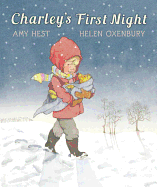
| Publisher: | Candlewick | |
| Genre: | Animals, Pets, Social Issues, Dogs, Juvenile Fiction, New Experience | |
| ISBN: | 9780763640552 | |
| Pub Date: | October 2012 | |
| Price: | $15.99 |
| Starred | Children's & Young Adult |
by Amy Hest, illust. by Helen Oxenbury
Amy Hest (Letters to Leo) and Helen Oxenbury (There's Going to Be a Baby) perfectly convey the intimate bond between child and pet, as Charley the dog woos Henry the boy (and readers) until he wins a place in his home and heart.
As Henry wraps Charley in his old blue baby blanket and holds his newfound pet in his arms, the boy resembles a parent swaddling his newborn. Charley makes unwavering eye contact while Henry shows the new furry family member around: "This is home, Charley." As Henry's parents spell out the rules ("I couldn't wait to feed Charley every day forever"), the pup naps on Henry's shoulder. Charley's fur matches Henry's hair. Henry's parents are "pretty clear" that Charley will be sleeping in the kitchen. ("I thought about Charley in the kitchen, alone every night forever.") Oxenbury's vignette image of the inevitable "accident" makes evident why his parents want the dog to remain in the kitchen, just as Hest's echo of a phrase ("every day forever") portends Henry's inevitable bending of the rule.
Henry tries not once but twice to quiet Charley's cries in the middle of the night before breaking his parents "pretty clear" rule. But a reflection of his mother in the mirror on Henry's dresser suggests all will be forgiven. This gentle tale makes the ideal gift for a new dog owner and every dog lover. --Jennifer M. Brown, children's editor, Shelf Awareness

| Publisher: | Margaret K. McElderry Books | |
| Genre: | Girls & Women, Science Fiction, Fantasy & Magic, Juvenile Fiction, Action & Adventure | |
| ISBN: | 9781442430006 | |
| Pub Date: | October 2012 | |
| Price: | $17.99 |
| Children's & Young Adult |
by Moira Young
Rebel Heart picks up precisely where Blood Red Road leaves off, with Saba's true love, Jack, on his way to the Lost Cause tavern to tell Molly of Ike's death. Meanwhile, Saba, her twin, Lugh, and their younger sister, Emmi, are on their way to the Big Water in the West.
Saba may have killed Vicar Pinch (the self-appointed monarch, à la Louis XIV), but "you can't kill all the badness in the world," Jack thinks to himself, as he observes what seems to be a new strain of Tontons at the Lost Cause. These black-robed men are clean-shaven with short-cropped hair, gleaming boots and groomed horses. Only one man could be behind this: DeMalo. Saba sees the dead following her, and hears stories about Jack joining the Tontons, and once again finds herself torn between DeMalo and Jack in surprising ways. Lugh told Saba she couldn't trust Jack. Is he right?
Young introduces new landscapes as breathtaking as the heroine's environments in the first book. Saba starts out in the aptly named seemingly endless Waste and travels through a lush land called Weeping Water. She meets memorable characters such as the lithe Sky Speaker, Auriel Tai and old man Slim, who wears a pink dress and drives a dilapidated contraption called the Cosmic, pulled by a camel named Moses. Saba continues to struggle to determine which rules her fate--her heart or the stars. Readers will be champing at the bit to get to the conclusion of this poetic, action-packed trilogy. --Jennifer M. Brown, children's editor, Shelf Awareness